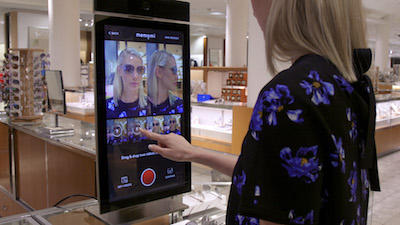NEW YORK – To succeed in today’s competitive retail environment, brands need to be fast, fearless and flexible, according to a Forrester analyst.
During a panel at the researcher’s CX NYC forum on June 19, speakers noted the importance of meeting the modern empowered consumer with experiences that make shopping more convenient and positive. Putting the consumer’s needs first when designing everything from an ecommerce site to in-store environments is key, and can lead to greater loyalty and spend.
"Retail is hyper competitive industry," said Michelle Yaiser, principal analyst at Forrester.
"Unless you are in a niche market in which you’re one of only two or three retailers who sell a specific product, your competitors are a dime a dozen," she said. "And what really differentiates you, what really brings customers back in the door, is the experience."
Consumer-first retail
Consumers today are more tech-savvy and sophisticated. They are also prone to experimentation.
Forrester's vice president and research director Fiona Swerdlow pointed out that some of the shoppers who are most progressive and prone to experimentation are on average more mature than the typical idea of millennials. At an average age of 34, many of these consumers have families and are established in careers.
While mobile shopping was growing for years, it appears to have stabilized as a percentage of ecommerce sales. While about half of U.S. consumers find it easier to transact on desktop, mobile influences about 30 percent of all purchases, both in-store and online.

Half of consumers find it easier to buy online. Image credit: Saks Fifth Avenue
Even with consumers being increasingly demanding, in the past year, retailers have been doing a better job at customer retention, according to Forrester’s 2018 CX Index. However, while repeat business is trending up, consumer advocacy and emotion were flat from 2017 to 2018.
Presenting the findings, Ms. Yaiser noted that brands are now competing with players who are even outside of their field as consumers make comparisons with the last great experience they had in any category. For instance, if a client has a positive experience with a bank teller, they will expect a similar level of service from a retail sales associate.
The different between good and excellent experiences can have a significant impact on loyalty, spend and advocacy.
For instance, among retailers, a good experience will lead 86 percent to stay, while an excellent experience results in a 96 percent retention rate. Similarly, good experiences cause 81 percent to spend more, while 92 will spend more when the experience they have is excellent.
Consumers are also 95 percent likely to recommend a retailer to others if they have an excellent experience, compared to only 84 percent whose experience was simply good.
On digital, a great experience involves making it easy to find products and complete a purchase. Other services such as click-and-collect can also help deliver a positive experience.
Rather than being creative, product information should be clear, allowing consumers to gain an understanding of what they are buying. This is especially imperative the higher the price point of an item.
Offline, stores should make it easy for customers to find sales associates. Consumers are also looking for staff that answers all of their questions.

Sales associates should be accessible to consumers. Image credit: Hugo Boss
Similarly, pure player ecommerce retailers should have customer service representatives who are knowledgeable and answer all questions with clear communication.
Emotion is a key opportunity for brands to improve the experience that customers have with them. While retailers have shown improvement in recent years at making their digital channels more convenient, the emotional scores for Web sites and applications have fallen.
On digital channels, brands should also pay attention to user friendliness. Jennifer Wise, senior analyst at Forrester, presented research about the features and functionality of retailer mobile sites, which found that the sample on average only scored a 58 out of 100 possible points.
While some brands such as Wayfair and Home Depot included features that made the customer journey simpler, such as leaving breadcrumbs for easier navigation or offering streamlined in-store inventory searches, on the whole there is still opportunity for improvement.
Sites are often difficult to navigate with low-quality content and a long checkout process. Brands should also think about integrating customer service at key moments, such as Apple’s chat feature at checkout that helps prevent cart abandonment.
Ms. Wise noted that marketers should keep in mind the customer’s needs rather than their own goals when building user interfaces. A retailer may be focused on upselling, but the consumer wants to be able to easily find what they are looking for.
Anne Bridges, senior vice president of omnichannel customer experience at Bloomingdale’s, echoed this idea. She suggested retailers really think about the consumer as they launch new technology in-store.

In-store technology is only effective if consumers use it. Image credit: Neiman Marcus
If a touchpoint will add a step to the shopping journey or make the experience less convenient, it probably will not be effective. In her work, she spends time observing consumers in-store interacting with devices and she consults sales associates to additionally get their take on new technology.
Evolution and emotion
Beyond customer experience, emotional appeals have a place in luxury marketing, helping to create a feeling around products.
Emotion is at the core of all decision-making, and for advertisers that means learning how to activate emotions in consumers to influence their purchases.
At Forrester’s annual Consumer Marketing forum in New York on April 6, a principal analyst for Forrester talked about some of the ways that brands can use emotional appeals to help influence customers as well as the way emotion ties into decision-making. Emotion is a powerful tool and while people might associate emotional advertising with the heartstring-tugging ads of animals in need of shelter, the range of emotions marketers can employ go far beyond that (see story).
Along with basing buying decisions on emotion, today's consumer is armed with more information than ever before thanks to online research.
Digital has changed the way consumers interact with bricks-and-mortar stores, and no sector has felt this more than luxury retail.
Speaking at the National Retail Federation’s Big Show on Jan. 16, the CEO of Neiman Marcus spoke about the ways that digital and mobile multichannel tools have fundamentally changed the ways consumers shop. What has become clear is that customers are coming in to stores with more knowledge than ever before (see story).
As retailers look to deliver excellent experiences, they should listen to their existing audience.
"What do your best customers love about the brand?" Ms. Bridges said. "Those stories can teach you a lot about what it takes to retain and grow a customer."
{"ct":"UlEcBfXza2+1oebIJIiR4+PJidm3Ghjyt5PqCXMmfDN\/soXlHi3M5sRZBIjy0tvzC8XiKc5B0vWYcYha5sOfn6Xq6C0sz4WpAi9uIEInsk1tEEkWCvlw6CmiMV3bzlN8pjvzpCD5rRikDISFMdAwbtce8sH6RDCL\/p0uX72tfheTorxL9Zgszryg+jO\/aMlt9D9Z7lUhnLH5g3jlfFnCeSedniyN3smGx0Jyesxcjo0NPwEiCjux793VS+DsmCrBMyxE+VGcxXkOuKrrr3iju50sX9VusvbqJpgH9q2JIA6Ar\/gTpfeBH5ajZVmrKYH4PBh0fGRImFFjS1yjctM9xbevFx3+KUkpEohi3plBO004iEJSEk0X\/KFP0\/b+BrKJNXxVlhMNVHjlzotHjnmNv6hIhcsnnAOybT5kv1BZMvm8FTqyb9MTYJ5DkColHTH8Zddzy0kzunRZImBw+nOMYfZM0OVdiljkYd\/UfFjA\/Xttn+mmpqlR9TZSwg64HWsU\/FY4u0P0IwXELvgd30Oio\/bZu93QRmtL47+I9n\/0A\/rO+DH2fJnMSYgeR7dPcig82T7+p1\/UsDD3REZJRtc4oNeCMR439kfJF\/UcO62O1EFYJomB2Ah6+FGQIFOCIed7MV8LKdYKogakMmsCetMumoRcHiKaKdkxe7GKp2VTGReaNTsrtRIs47L983djORwPYk29wvl3joAnp7c0i0MwlaYO\/gxhsrePMLxi24sr56HwMqnQ9yO28TannQabJNjH0rdgEuHYZ5TX0UyGcv7xlSs6YCQ8nT\/nS0tlmOGwv839u56Chfa2NgVBf9UPvZWk4w0zGMAoGpOdDAl6kHycL7+avCyGUTPXB6rAYCaX94sW5ZaLlCWKMI5dk0lbJgxxFEsl4dB2ciAe4GyPY8XJ71PWnLf8RctpCojZtO2xTmhwUunSbq1KsZbBfpg6YJLACox0PE1EyDOqC9GlMOD\/6m9\/fj\/t4+ZebbB7xilF\/joQdFfcavlpMjCOtsrHZc3LoM4\/7RYhZhbkfgeSJHf5UHWErPIPF5Tz7QKxe1PDnKRjVFWl5JLRQXT\/Rbp4wZqoojwZ0NXMx90cQyTo3jyWoDaRDqXaIYnVblEMlg42p1F\/0QrJmcvn1ug5VNw1FmMkiSJjo5Sjf5FfiuvmU7WjIrU6qKgOvz4psM5cdeTPpKEFWbocS9a7YemdEb1h0YYDuwNlfcqjnSzlgM4RJkK7KdAFTKvPi+2Fh1hKCuYx46ZQA1SwmzCku5qlKbJP1qzsLvjUkbs5W9MhvKyYnacNNic0MXyl6CRxXyrxuZEFj89WAm0jUlEFfSKSTTQF0uq4Ikmfuo1TXIRyQ0+f1DVnH5qCqpzbO8McJ4\/m4Qb3IRbswq4eYjPlz31Ck8QbOKY4HBdu1Xm\/HzT5YbTChqigdeiFcVQm\/49GEHDhZq69D5R3NPyZGMLWMEWakvC8nC3UkpgNXM0VS4+\/nBmnaOyQNhhdGKF4DC5fMpeof1bJ2VRSgfZfZ5a4gJfT2KgXpdIbIwEqt6yud8TTeh5CflkuCgUzIZW3bBZ23kLKeQ7z1QQR7j0kiRoSE6\/8UtwbJiGrGpgJV33KxP5lpUj3LFOapAIbjt0EfElXLLjlffHpv3sKW2FwWMUsAEvUarDIkHAFKGKD\/WOPq8fqH+pcFJNwyMvFq1aVrawabu3j7Lmw48nVeQbSieWz91cJ0duOgFYtLRJoY9UfZHbWknS95YRzXiim6Ijvp+SeDDsiZJlUWNMXvW3bEomqeeB5CLOHSsQRi+C2xIwVHNKG3T86rO8OoXxPRJ2amSHZbO7Ita7sGjZnHdOktLPuCIor70U\/4yOIv0xLzbBCPhyv1aGL\/CRZHRdDYO7Fy2i11oGoeu7CMB9dy6Txduwj9Fc+G1GZZzbHvCag8B3gKd2KuhO4KTQHdklM+ibjNa31EI6KRCRJQzp3b8BLwJSo0uGo476+8Y1EJ2MUtcyv6hqCSdXhF83xoM2UVKNRFulp1YdEeErga1bUGwcg3mb6Ka8lQs5AfweLYm3EL8aaDA88gMPjojcdyPHfqvtqYjDlPC9hpYy+kmbd4PVrODG1LY9NK\/ZBGgz\/\/a7iHZbtxp+NrRYj5UvCDSGVlwmuJG0GJRnxmWtcecwE7LEw5emdccczheTIkBJXFndKLbAc6RWmdMcaLq9yaX0SKe37Q4l7xOyzOBnYdJ7C0hoApVoWhKEr6LriooAisxF4vGNN3mMCHrx3E+uT4f9P9L6Zah0U2l3AeFTBFFUcgqWIKPSiRHCuKNkOlYa41PByY1729fCBsV1Yj2OO+0u5XaN8+GGV2PB9Jdg5IrEwvskEhHc+MYZUyGuLAn96WheicXsOfp2hG7uXYsN++YJRXTdJoVjCrbwz\/gVync8lM\/IDVrLZteTbTEpdtqvUuxCdo1FWxZ+JTXhG0wkQw\/5Du5UE0KJZb99Lrk9HVzQ6Lt5NeRy+qxUuTseT9WKlQsi+1Jcx9pwpmDccmi40F2DnJb49iOksSG3kzlpSqIlfHwN1i4fBtXjivAmszO9racjAtRX2kbOrZNHdPXxu4orEXqaPLS4JBdGYaiZ0+dDNOKi6FRJ1y70r+JNNUHLnte3ytsCfnVWdIqbqKRMzyfHb\/9NOWrBAxOUyA3mRz1aNCHNRzESXW8p6GOdoeuy2F9w6viEg63sGQqGbXJYKfS8ao3kJ53BYFew8C7QploN\/vT\/Vz3RjY\/PcRpvWxLIiPdYlFrRi\/rXvTyqNd0uuJOLxIwaAIYQvx6sGMcYyJex4fJFgHVVTR+2CxyiSZlhlLNW5J\/9+n++wHUAh91tDVNyU41z4TnIWya+GccY5Gnj9iQpuMUUZW7ymCbkxnv1njAoAq+K9MJykziC8GHkFa7Wb4\/D62GVHKmzgeAjXxNkUZab46fFioV44RHvZquKvUUADwexCRIc9uWEdjuHN5O22o3QAu6aA5\/ySXb8YcO\/Fwdcthw1XJRhaGlrd53WaG5Z2SoVMWxy4qX+fhqUO7Qg2a8Glp8hPviTc2ACdonhxwQS3JfO42hBF+w9aFS72CyC3\/QCi1f+KsVCFlIDgqK6h5NHtWJb1gptCFxfa0Ka6GKhYjf2E+3TWnqi4LhMDayGqym9oJ\/HhFZJoE6AB2WG+XRHCfNowA+E\/sVYWcWfmw0LjXQARpfio99ZLL+FzAo7ReI+UhGdKVGl0EFv96VpyS4Q31qRhvxxCp1w8nZxxlEOSixGeZeabPEgegnJsuViychyOV3AyfbejGnwMhOEXkjNXXT0Mq9M5U0rigVB5zcoWn2e\/dkC1SLWot7EaErh2R08rYn3IleqYYdaAH21O2UJr3JIEHzGKNYPt5P2rfiRY0d62RiOtdchIw0wjzUWw0W3XvPXhx5XIgiGg5d1Ly6+yHN2cqnU5kln07Cce0uSqdkB5w0lJbpsNUUOQAo7Y6IxBgJkUYP24ejmOnKFI5WjZz57rNJgbnGljuXIJ5z5ohsYZlBAd7QB2\/fSiB+hAyUa9FggjZ8RPVjmdrTnETqBIDO4mjBXuGzKY+fRZmB\/hivTVFEEltloHLryfbTnsK0gEED5kNCikctKDZ+0cXqYntuiFxeIwJ8EEMOEP1ccgDJA+GI48mqv9Bz6REo4WU3r00EUfLFK5MK1a4JXNyR89lIh4\/X+YWJZPeyl0SsYrWltdr376CMyOJr5IFqYubanamaBy0aPqszC7q0BmxAzVR6554uxoBzKQwXA\/4X3qn0ozo9nq5xtzaHivep9ynxtN83zpUsN43VGWQBta9bgkORFPx0CAaElIYTTr8ZsBri6ndlUZapTU6gV7JJmjIvPX40\/NuzVLLIxLmdi1eXtZoWQiVy85gcT2id0oNqfeWVE1goCr0Kmxr8UU30NMaGBhXvI\/2Ongf4h+2UN6uNhPjMfWMF4yYfhujDyu+8OzdhZsE1uLU7\/KToAPQM8Gd7IKgEZusOXRNPb0BmeYHx7jsAR\/Wfm3zI4N56JyRQhyaDDvv6wQTk0szGJSe0fCO0BLbonpnGg7kXrk8mjgr14VvIYI8BPLv27oXVwY458OQ0Ip+70aj\/RPDOH0zfweUXmcZM8tYbHhNo4YlYuEnLFuEhrhtER2XCC3vQmmV9mMF1y1s93cJ3+jUZ+jGS3h8+0Sm4p\/8b0zqq1d57jtOD3CcpNJcpDDM+uIRTVD0ppsViZtj7Cen2yMcMMxxylgQro38ZzyUVxpmpe18fv26+G045mLhVBwg3TvZDEGVH8jHFEGHYyiTwfz+x6oLGT5UEG9KZaWJrAkTxEqZBpaPf4Doaxcwd\/aCRmF6whyWBsxcS7dbgxYMiETzlb2X1n+zmG0TWodtrBQIQjiUHP\/B2oxKgNrVIgS0jFcUivMIj1Ibb1Z45TiE2hrAbO\/KB9pV\/NiszbqVMpg58dzR3Suf7geg4M30Ud3BRqrUnEkCP0k5m7B+txAYxfxdtpXPb1uvr1DwXrQNXUI5AxZahan1HII9mp94DyrdGLWzMIzv4z5IP9u7jHh7lsKZ3oNA45fN+WERNrnbXQy1JKMSqiw2YqpGucyKIfJz3f2ZLVoaq7\/Jo0qZ4+0fQZ+dAjx9D2nKX\/InLQ59X+5LQkqhFqnIPGBN3hGZ\/8hNJFK2Zo9fr0gmeU3T5z4YyrWaB+zEEbZITaWfX\/nxyaeJIiR1qOsg1KSCdMrYwKCf5arh7AcLC1Uw6+Zrai3O18smquuo58N6V\/2BFeb6kMo+sy8zPPA0S89uQiJZ2my0CpIJ\/fGPcoBcs5u\/WzxNp9Mk33AaeVKoGLSPE7GXA9EWsgokmn\/yoUvSitgYf8MQCvG75d\/ByFKu18vN8j1q\/6KW3tdsRGgi8v+SCYjy\/sIPPoQ56fz2BYJK2pvTQD4l1KmdqydON0BBOwsBHaTpv0aGfRLJUplj8OQXv0zGsSeGSkbyV47kaw053XSWsuzkemfdiF9jcynhM1Rq4IWm84Hz5gsVFiz43h+P55edq0TaEjBkSHJuqF3cWdzT0zyQF9yk0N3OFoYHx3sjGJJcDaIDZ8j+oxkSyulmVmg5q3gI5qImtXcbICXlGQTAh6dkR\/jLRl+bpodiHFNbQQ\/VYkxAjJ4F0J8V+ZHFzl6v\/rYMoSAHpTyiyKxtzozYeh9Zw39Q7gGWSTKmMNz7ia+iDPaZY2p\/zdJJXrO7LTcpzml5dtxSO4uuanukndbDdHcN+XHp6v20hevtpodvZ5A5B1y5Gmq1KseAeZZjX92yLj3d\/QnUNziuD5megBDeZCdeldEIM6UldnKYZ0+6Lr+ZvtYt2lB1QoV2QWf8C88Kxg+aKN2PVVtCyhwcBXQBjx8cPo8vfXCJ72+\/qku0nkVAG0a2JDi7mpYBVjLsZousqwNnCJ0u5L\/apcYlBiDLQc1XtHpxROPZVes1Mm6gaNAw0IXEvswgajF+GN0ZhwGfEEydF5x3gwsj+aKhvD1NeJNHHj\/IwYZ4R4Ju3xl7TKy5AV+Dqc\/ffo9XZSy2XqdaCElJH6MoO8ylEWzpnch4Dmbhonr5OwG2ywJCL9nLoeh6dRyNsdu9ShA5Civ\/FkutSEgZXh\/hzffcmwKVHP1O0c9+diinAqH8aFXYFx6XpODph\/zRVU4XWFmEXAM3v9X9lBJFek9guWZyeUGKhDHRBIctUeeiBhMS02gjwY3GZdoakAKaUGdpH2ItkIQMa2GHsNZiXTR+AQKxCrgbvP6GWX5ltDGXpjD55BSrkeb4iJTLg13RwZT3uVlsXkqjCgjqFwR4hWvtctIjgMTTeOe+Uq9R8myD7gviJ+cqn6SZBzXwZe4hFroXuqucL94gh0Jdx2UeqFJ9\/lFpRvtErOGMFWzijezWdh7RBB6N8vwXQZMn64vgACPQQioMFqy2nie163wjVYOTjfNWP5N+dvaq2cVph8mNNCnhulW\/jkPi8VMEA1xD1NaTdPVUX2QyQ+XcVL8TsQPID5uLStx\/7SufCqWt\/E4Ndn0W8hjZmjwv56OlM8EovzStEyMihbFeAqU1b0g0A5F6IWcM5gsIzTvBw7rGO8LZnrNWehPOlCgxZqN2ZsT+DHYzMgRmQfUVk0jXkmBsRYsNjmLnuYVdLLfoTBDQUWCqlC\/HkXBFtT8JL+iaCbWF3w\/NFblBhuXR3sAaa0xXFBErrPPXaSWbVbjcYwRjKkJZRCA3sovYkgB+hlNjBpdfICl2nyefKl\/nt0QruMZ5cpjuLoVUE+GPNY5B5Dvz8l0MP47y5wvko+gKAPb4HYWmRQkGAT\/7tVRcNcyFGNhl3lBNOthuaTr55qUee2y1ba5abjoC6DyYlXPTwAcjNkaU1EHYFqW+GA1rqtAli3L6NJUHNWJqC2pJPCIrnUaTvjou772xvPj9+GDmNgWfiP06JehmIzQS09uD3QqLy9zZdCKhatVZzckkwFVdKRkeFVbOCmrpO6W4axXhnNEJvw\/ZErr8XxScpSEvr5DqIOB+jniATH6TTlOPepCC4Ld67ui+gprtrJ5rHQhX1iyhNYa3qMijrFtcy6gf3JPP1dmdQakjib5Vu\/H5iX1I0ERnoWXSN9nUvoxDEQXNiI2UpY804urQHGfpZQufwxBp7AKjRMMJmxfcgIjxixMI8uLLhi152b0ZISA9MQW9UZQkVzoM68JkkLDrkyft+\/LSbCo\/0lbmKZfVL6B4WZIXKh4W28TwlzMI343K08WC+9NQ3\/5dU2\/MGIVh5JkNuPZRqesV8pHKZcHCzo+TQg\/ng9YUAzewnAucmiAvohQC+BKueukdz1s2xQwrdWehDdCNJ63QRgPo8X3l6pSYP6OAJNQAXeLMuBoerxBqSLEVE8bDvaj4U6h2CWEbnJUzVXTaHSYnn9T5GU4xNzWzXigZarsnOz63w4USWzhQf0Tfd9s5xwzvkTl5QKbKvX+nXBgPnvCjvtuijNWgndmKIMwpVw+TqR9YirlqiJcMFgyw6ns2acRDwScQPrrtquIK9oisTIP353MMavHekvsCzziM0QiwgMBb27iPQYhim03SXV0GO02NBoV1dS2dKf6v8jJDvlxZCXqrmDXz+LQPGZhMXz8ER08GuI2ZMcJ6zbMjgXHdLlXBtLTfOGxOxfCid+ibXvskcrCSBLrUToicsuA0zZj9MbF3arkkVaEzo3si2gQh3LUAoqrP1P\/Us2JJlH7Al7IkJlpQGWr0ZcK\/U4OpGv1wTvio9dhcwBRxwNVMlGOy5w0BiuHfa4svS58D+wK0TOl2FfRt76H1++a5vrhoSQIl8UL3NtfDY0mxLIekg6oNp5EyfPcwLrcJImc7K\/yIF9ttJphs72ifGU3k4WbNkX90hogFJ3VYgG8AUAt2uXJacGKkJuJR6x2EmmG17\/laAv9U+KzSAgRHEKCy9D9+izR2GwGpBnyjkVy0qlWMl243WvMKBvBuNZACVdDHO3Z+QvaQ7dBjqU8rKpgrcXBSHO+xDqCsRuBT1PfNgo3AnZkvZiGAoZA1oX\/vZgkrl5E0RePo28XMaX\/UBxWLfALe064EF6dE8LfkNA0moTZOeGfhZdGHCerUFo+BcxWoXtI2psSbla+ERLTsgpw9wrFWVXf4C70fXToyt7V2TCF4yrwPbisJ76PJbdsi3ZiM2VlF+4T5cRaGfKAUGtsck15jQA00H4erUfRtORV1rv9wNNl9r\/tURNSTUYAU4jbBJ1Psd0db0nSQzfNSrzGun5ycfAui8wWy8hprrG6Wd2kNamahw\/P2vB0\/qs6I1bBUOmBgsTwn\/gz\/1K53mF3PZy8rtsX79EbVir7eW46SB1imK4XOE13AyCMjeE1GkZimEwX99I2\/5F7U5JOHsRneTNyeH078vIBJj+alB3p49yVqFg0OTx5eXOMC6rSEIMw7U5cQ9J226qPk342wqikCszThl3ER8sNM\/MbTx6\/WtAX\/74IFAM67wqmrIwC7Cz\/oeMteRgSaHUFDAhqOoG5cOKZWO+I3m4tHe+k4OXBdO6NL8NfRuXMFuItcak9NNy5q5cZKbFoYRxqNY7Gb8IKOS6Hg\/VAAMK\/h51O2yi6XIsyz6PrykedbyT+eKvaI0\/cGbInH9AkVOhbcoa7RyrRSaqxNo+x6y2deW3VhwriZP0HJZ1PSjtFvN3EfSTWENhjKhi++e0K3zUKk89WtTUzroe\/er\/KpuL0PNm3p18aY7C9ikS37EDZvSmj3qxmIGculkgeDHcn46\/7IQEma0g9dL97m6w7whBqOc3Ad7bNr1gJaDoIOJShlCe6YamCZFOttRrKxIYQ9ILagztG49UHITUi6GuAZ6bN+VK\/zL23fHBCcqafA1OagNxbtAAWFsGGyIO5PWNmXxzVgOk5yaLTuYusSgljNhaNs+isjlzxlYZfPgF6oP6MEdQMsiRVyZD82j3OOOJ7pACCGEXUsiFUw9RZDIRfqe2hTUpVTdtMmiPY1Qj1DJW159+9BvnvpxF7vqoJnEInpfI19klXIS2yUYfKvxllf05sWG+cso1b1YlkMEcnFB4Ue37WAiPCGk7lBzNR1voFL\/Ww4cQPYnEKKZRGUp4zgTanC5WUDQ8GV+XThMJZLUXNiaLHDoJS2Oo9jzfmrJt9HJfaLjksU3pYVcKqC6mhEhyPBwVPMGrZ7oX4UKCdbuwq5JPyT\/c62dG0bptG1v3t7FGh5fvTDgObEijenO0ttB\/8so3PX\/haoe6BPSH6fYX+1I27gEJE3i5Pr2ZPpCb3SRD+9NMs6XtMBzubyQvNuzSVi0rM63mn4DrMvlqpRxYKZV\/ZigW5\/60ZEqHPSpaZofi7kAjBLsqf8ZrnHNhsQNZyofr2b3A74KQooxT0\/jzk6wiPVthkeiEgF8K4KneBIKxrA0g+GoD\/GcovjKJWwcVbblkqdyIatInCnUTryQnVFfVed5pJ1Haka9p2cTAbKMdzmawTipzBo3KBQvSVgk\/0wae4\/cEueZGKbfa2zTHnLRIyHkA3a9MUhrSCuGEZpqInaHh96L2dqCK32aNxG2Mk0GqthzdjJXNG5dmmJJxeid2C347G8ItaWLcyLGmfxJn0Zp1WeC6+m9pWe7XLLM73UOGVlKF53AQ1iWhTpnpS3hZRI\/DpMtbwiV6HLkf7qNdUzIIv\/HPsRhFDGYc+osY9pN\/3W1C2KN7gj\/G133JilK2QFO\/wcXmN3NNlMwGhKN16GeVTj0iE5MV2SWVQ+oO2cKUr9D8eTq9Lk\/\/FgUdYDUKrCFBTSVIdb2JEgeWdH22JdDuIRvwKjJHbUvto3n8WvlDo2mntg4UZGCvSPg48XMLLwb5kqw0cMylVplF233\/lfHxhfAd4WiU+n4gi\/f0qIuRrPzAv6YkanrIHys3l5R92jKPkIhDV6hmCKzoq5fG6WgjgPqdlsObiSCRbsZchCo2CqcHIRfCIOGq0plrbVDnpTRPCOpvV51XE+e7J5LLuxL80KWuq15LZz06Qqq2mudHAttYvLF9Mz8OskXk0Z9EDE8eiSrY6A1gTxVWc3YAL0K0MWHAS8TGDPSVNkR+DG8PxrAy1uCbQ2vt2XdVjbPJb111445JQZ3MMymK8pkqEQ98klIuXVwVDgHx9OlVZf1JAFrhXHasxRwFemmoEPdtYGASNpr\/opW6dYgNFHzfAhmdMa6Lns1JmZAGUmdHAMTGYjBUUh7o9qdlgR8iY9WZ8D07HrFTyfOxtfB6+x9SB6IWDb4yXwtNK4AuAmgLavS9EA8C0vYRSPGQmNLK4fTdpoglF1TPlpZrS6n69eofCyDYTFDTPGhNuKdfDBvcoJpDrbRjSqo\/MBbTtDsjaIW+qeiPp5M0SXQiHnpXDj8SNSDUYB4zdEWSRlH1nJYvAhMdQG4WnfhVKyaEAC+nDOmocxl0A3YKLEOBFxMkt1uOxGIF83JsH18M2lpFg5AhWO10ys8j4VKQITD98RvuCTF4nrmfgJr7XtNQQvauhXrOxt4+zaVxYXb7EJMjzbwQrYUm9FWy4mL7eaD4EmjyHOXknPKyshgM73ll86j4Ms+VxSTjP+VxEi2Y95hqfLQKNMezlnmfHAZ7PEraK8BcMvmz0v9mAHwoQ8jTljCub7YjLHCCKap2cjZlEAj9HnRNafJlB1qIRgUEpTl+\/MaHbaH4jvXdlQ+vYGlU2QUgTvCSsgCDzM6JVWjclnBXCNgd0CEix0Pa9j2ht5D30tpRDZFONqXcqPkDmk\/CX1nuChWt6kW2cQDpz1QoCulxyMwFX3cUgT8NkSpq9n7QFIuJtl5u1KVV19GDvA\/9Z9snDq11EgtDuZtoSk0GdRpDqqoxIPNKB9EgTRxPdT\/IoBtcLYQG6civgRsaVmle9ISaNW4ED3tce+HvubypMNshECu5y7YqGzTOKEF4bF9RvHnvzjUTiESQnuXtJ5mYFkUQZ44mUAw2DtRi6NR+9ay5a6ud541VKdqiMN0BVWAKTQgffO2C6xtIZ5+Qk1Z0QP+w5rGQFsIWCQUX8qkwjXkSoqin2pT8FVvuuX4mfzMRkvSC\/\/QkEUkygZBuzRGgIP9AMeLZfguDB1D3klPSu+y9Mn0LjAXDVvHRrLMu9OD6wkkCWFoCTV91MQG3I6Rm9MtTkIn7MnsrsPVE6cNbpJegKko6yPUPk5XAFBZQM5fvEc4+gCN15u79hn9NZkK9QNmCmccUsWaL6zcOysBoqteYmC5qMbVijIhry6vGWb6gE2WhjRgw\/8iL\/vjTCyDuW9IP2Z3H3sZQNpso2+DFFsrcDxuwtxJ621YwurR7eyDYTYhZNPqZLfXgdYban5mn3NxYC1NIr4GArscyqvJLruFYsClPxFcjjhHT8vqii61Y5xXZ3Vj\/JZOiqFqzii5obmwhmeNiHp8s89xk8afyux2FkKCfXBI1Uot\/O1DpoHjpk\/7c4z1MC\/ML3KXsHLHwQ5Es3VkCsVcCBMpQL8mwKvgm05D2uXBu+lK+mf119fGGJWvo1uP0ZHjcjnwIT9iLTgndajsbNUM\/cwMJFgItd1X8MWO1CfXuV0e2olVq6X34BIB6j\/SQz0806204N5bHLFPngH+Xy3vjkhcqcrzbpPCKASUtM\/l6nURzF7NTbLqjKE+4ZvJnsqHiohLIlFZ45E02cmb6CWw6EJsrKARLo0Fj31wShmGeqBCun3RYQTGXon6jijnnK7WjtvQ0KauKMktyOjVsypKbSQCVrUk3+O3I3WktZyZ5g5nuagPqSJURsGcKSi\/ySjMMmnrmm71cbuaRHSsur2FG3W+zumTP\/z\/c7J7lp8lF8KvFZWdSgVLOWbUOWRwzEdXPf\/9PqRSircmPQuQ6EBZo6mw9CUAkx4LhvDH8QvQwzQX0WPeaMTQqy3Ccu1T15bdzjO2hMoWddyfD2d94B0YklXn9kQLd94M1Yvrp+YG0Woy+ZRFqXNlZqQNfrRJ\/M2etJaxZpbFH54byfd3V4X84k0RF2BW7Hm4+QuwEgMhM4+obif+i10yhCswIzP6azYuZKrr08VJn0lvHufFZv9ugHMIBIjYhX\/YpMAtYGXwhsiB8kqtsx7HT\/YXsMm7irSPeP3vtVw17kLtM4c5l6WlHefCPdlhWS0CeJPs+V8IEp1bPKqXXebcbKa57ifTkOBm+3dPk28TCBOOai3mFq3LlCSJ7VZV7qT+oiA7Cjh2uLzBknc2XDNErO+sqIiv6zjnvswidbhNj4Uy9YtsRLdnmBi+B4cAZy2XOy0OXeUpDE7eE+m47mNKPgDiRAPLgkZP+KkNG2490IvpT\/Bvhi8rAWYL8PVnTMd5me255e7uspRxYrOZserFObji+\/dV7U3KU+ex88maEG7Ahuk4Nuy2+tWSXwpyCfHGgHiD05FXteboZAnJsKnbOOIC1lCmLUpCBLCU0K0GcexxT4HkfoduONT6YgD2aRyZv8YzkROzWmYJKOs5dQ58IhuhpBV7yMPB+UHg9LpzOiAqGAU4YVUfqhPBbsiY\/o+PsHgG4jFjxevEMcm\/o4kBFF60rkRwyBJuaqOc3gfsKVHInuDcnu\/yUrSozfA49T70tGWFZoUvfPp6whMjLhgkPhqXx+WKkNyCbO1TjuQMs5uu\/vPFKDyw==","iv":"d25decb9aaa06fa45d3f84ed8307857d","s":"b9f10909d3ce87d7"}

 Neiman Marcus was one of the highest ranked retailers in Forrester's CX Index. Image credit: Neiman Marcus
Neiman Marcus was one of the highest ranked retailers in Forrester's CX Index. Image credit: Neiman Marcus